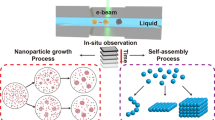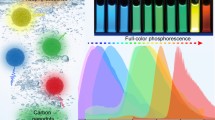Abstract
A simple liquid-phase laser fragmentation approach, resulting in the rapid transformation of CdSe microcrystals into colloidal quantum dots (QDs), is presented. Laser fragmentation is achieved by irradiating a CdSe suspension in dimethylformamide with intense infrared, picosecond laser pulses followed by surface passivation with oleylamine or different types of phosphines. The generated QDs reveal perfect colloidal stability preventing agglomeration and precipitation, and show characteristic QD absorption and fluorescence characteristics, whereas their emission properties strongly depend on the surface states and applied capping ligands. These QDs show distinct photoemission under 405-nm single-photon and 800-nm multi-photon excitations in the 560- to 610-nm spectral region corresponding to the QDs size of about 1.5–2 nm in diameter which is confirmed by transmission electron microscopy.







Similar content being viewed by others
References
Bowers M, McBride J, Rosenthal S (2005) White-light emission from magic-sized cadmium selenide nanocrystals. JACS 127:15378–15379
Bruchez M, Moronne M, Gin P, Weiss S, Alivisatos A (1998) Semiconductor nanocrystals as fluorescent biological labels. Science 281:2013–2016
Bullen C, Mulvaney P (2006) The effects of chemisorption on the luminescence of CdSe quantum dots. Langmuir 22:3007–3013
Coe S, Woo W, Bawendi M, Bulovic V (2002) Electroluminescence from single monolayers of nanocrystals in molecular organic devices. Nature 420:800–803
Ding W, Sylvestre JP, Leclair G, Meunier M (2012) Laser fragmentation as an efficient size-reduction method for pulmonary drug discovery: proof-of-concept study of beclomethasone dipropionate. Int J Theor Appl Nanotechnol 1:99–104
Giorgetti E, Giusti A, Giammanco F, Marsili P, Laza S (2009) Dendrimer-capped nanoparticles prepared by picosecond laser ablation in liquid environment. Molecules 14:3731–3753
Greenham N, Peng X, Alivisatos A (1996) Charge separation and transport in conjugated-polymer/semiconductor-nanocrystal composites studied by photoluminescence quenching and photoconductivity. Phys Rev B 54:17628–17637
He GS, Yong KT, Zheng Q, Sahoo Y, Baev A, Ryasnyanskiy AI, Prasad PN (2007) Multi-photon excitation properties of CdSe quantum dots solutions and optical limiting behavior in infrared range. Opt Express 15:12818–12833
Jose R, Zhelev Z, Bakalova R, Baba Y, Ishikawa M (2006) White-light-emitting CdSe quantum dots synthesized at room temperature. Appl Phys Lett 89:013115
Juang CB, Cai H, Becker MF, Keto JW, Brock JR (1994) Synthesis of nanometer glass particles by pulsed-laser ablation of microspheres. Appl Phys Lett 65:40–42
Juillard J (1977) Dimethylformamide: purification, tests for purity and physical properties. Pure Appl Chem 49:885–892
Kenth S, Sylvestre JP, Fuhrmann K, Meunier M, Leroux JC (2011) Fabrication of paclitaxel nanocrystals by femtosecond laser ablation and fragmentation. J Pharm Sci 100:1022–1030
Kucur E, Ziegler J, Nann T (2008) Synthesis and spectroscopic characterization of fluorescent blue-emitting ultrastable CdSe clusters. Small 4:883–887
Landes C, Braun M, Burda C, El-Sayed MA (2001) Observation of large changes in the band gap absorption energy of small CdSe nanoparticles induced by the adsorption of a strong hole acceptor. Nano Lett 1:667–670
Mafune F, Kohno J, Takeda Y, Kondow T, Sawabe H (2001) Formation of gold nanoparticles by laser ablation in aqueous solution of surfactant. J Phys Chem B 105:5114–5120
Michalet X, Pinaud F, Bentolila L (2005) Quantum dots for live cells, in vivo imaging, and diagnostics. Science 307:538–544
Murray CB, Norris DJ, Bawendi MG (1993) Synthesis and characterization of nearly monodisperse CdE (E=S, Se, Te) semiconductor nanocrystallites. J Am Chem Soc 115:8706–8715
Newton JC, Ramasamy K, Mandal M, Joshi GK, Kumbhar A, Sardar R (2012) Low-temperature synthesis of magic-sized CdSe nanoclusters: influence of ligands on nanocluster growth and photophysical properties. J Phys Chem C 116:4380–4389
Nichols WT, Keto JF, Hennecke DE, Brock JR, Malyavanatham G, Becker MF, Glicksman HD (2001) Large-scale production of nanocrystals by laser ablation of microparticles in a flowing aerosol. Appl Phys Lett 78:1128–1130
Qu L, Yu WW, Peng X (2004) In situ observation of the nucleation and growth of CdSe nanocrystals. Nano Lett 4:465–469
Ruth AA, Young JA (2006) Generation of CdSe and CdTe nanoparticles by laser ablation in liquids. Coll Surf A 279:121–127
Sajti L, Giorgio S, Khodorkovsky V, Marine W (2007) New nanohybrid materials for biophotonics. Appl Phys A 89:315–319
Sajti L, Sattari R, Chichkov B, Barcikowski S (2010) Gram scale synthesis of pure ceramic nanoparticles by laser ablation in liquid. J Phys Chem C 114:2421–2427
Semaltianos NG, Logothetidis S, Perrie W, Romani S, Potter RJ, Sharp M, French P, Dearden G, Watkins KG (2009) II–VI semiconductor nanoparticles synthesized by laser ablation. Appl Phys A 94:641–647
Singh SC, Mishra SK, Srivastava RK, Gopal R (2010) Optical properties of selenium quantum dots produced with laser irradiation of water suspended Se nanoparticles. J Phys Chem C 114:17374–17384
Sohel MA, Pan L, Tamargo MC (2012) Studies of surface oxidation in ultrasmall magic-sized white-light emitting CdSe nanocrystals using X-ray photoelectron spectroscopy. Phys Status Solidi C 9:1776–1778
Talapin DV, Rogach AL, Kornowski A, Haase M, Weller H (2001) Highly luminescent monodisperse CdSe and CdSe/ZnS nanocrystals synthesized in a hexadecylamine—trioctylphosphine oxide—trioctylphosphine mixture. Nano Lett 1:207–211
Tamaki Y, Asahi T, Masuhara H (2002) Nanoparticle formation of vanadyl phthalocyanine by laser ablation of its crystalline powder in a poor solvent. J Phys Chem A 106:2135–2139
Wagener P, Barcikowski S (2010) Laser fragmentation of organic microparticles into colloidal nanoparticles in a free liquid jet. Appl Phys A 101:435–439
Yang J, Ling T, Wu WT, Liu H, Gao MR, Ling C, Li L, Du XW (2013) A top–down strategy towards monodisperse colloidal lead sulphide quantum dots. Nat Commun 4:1695
Yu WW, Qu L, Guo W, Peng X (2003) Experimental determination of the extinction coefficient of CdTe, CdSe, and CdS nanocrystals. Chem Mater 15:2854–2860
Zeng H, Yang S, Cai W (2011) Reshaping formation and luminescence evolution of ZnO quantum dots by laser-induced fragmentation in liquid. J Phys Chem C 115:5038–5043
Zhigilei LV, Garrison BJ (1998) Computer simulation study of damage and ablation of submicron particles from short pulse laser irradiation. Appl Surf Sci 142:127–129
Acknowledgments
This work was conducted in the framework of German Academic Exchange Service grant A/14/02402. Additionally, the authors received financial support from the Deutsche Forschungsgemeinschaft within the excellence cluster REBRITH (Exc62/1), and the Collaborative Research Center/Transregio 123 “Planar Optronic Systems.” The authors would like to acknowledge Torben Kodanek and Andreas Wolf from the Laboratory of Nano and Quantum Engineering in Hannover for TEM and the excitation spectra measurements, respectively.
Author information
Authors and Affiliations
Corresponding authors
Appendix: Stability of solvents towards laser irradiation
Appendix: Stability of solvents towards laser irradiation
Majority of organic solvents tested for stability towards laser irradiation in this work (toluene, chloroform, cyclohexane, dichloromethane, dimethylformamide, methanol, ethanol) showed certain signs of degradation. During 5 min of irradiation with pulse repetition rate of 5 kHz, the color of toluene, chloroform, cyclohexane, and dichloromethane changed drastically to colors between dark yellow and brownish yellow. Under the same conditions, dimethylformamide, methanol, and ethanol did not show essential color changes. At the same time, they showed raise of absorbance in the UV range (Figs. 2a, 8) with methanol exhibiting the lowest increase of absorbance. Except methanol and ethanol all other tested solvents after laser irradiation had rather strong fluorescence emission when excited by 405-nm laser diode. But lack of such emission in methanol and ethanol can be simply explained by the absence of absorbance at this excitation wavelength.
When CdSe powder suspension was treated with laser radiation in ethanol and methanol there was observed essential and almost identical growth of absorbance in the whole visible range (Fig. 8) but without any distinct peaks typical for monodisperse QDs. The laser fragmentation products also did not show any noticeable fluorescence when excited at 405 nm. Such results could be explained either by formation of broad range of QD sizes that lack surface passivation and rich for surface defects leading to nonradiative excitons decay or by essential chemical degradation of fragmented CdSe products without formation of nanoparticles at all.
Rights and permissions
About this article
Cite this article
Zholudov, Y.T., Sajti, C.L., Slipchenko, N.N. et al. Generation of fluorescent CdSe nanocrystals by short-pulse laser fragmentation. J Nanopart Res 17, 490 (2015). https://doi.org/10.1007/s11051-015-3303-z
Received:
Accepted:
Published:
DOI: https://doi.org/10.1007/s11051-015-3303-z





